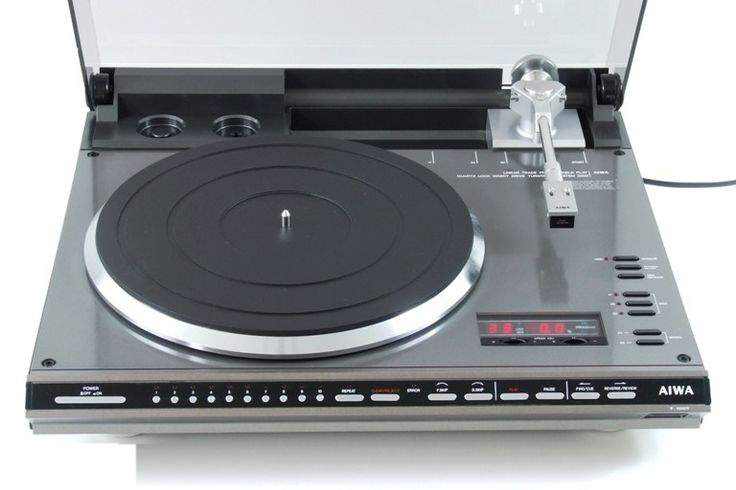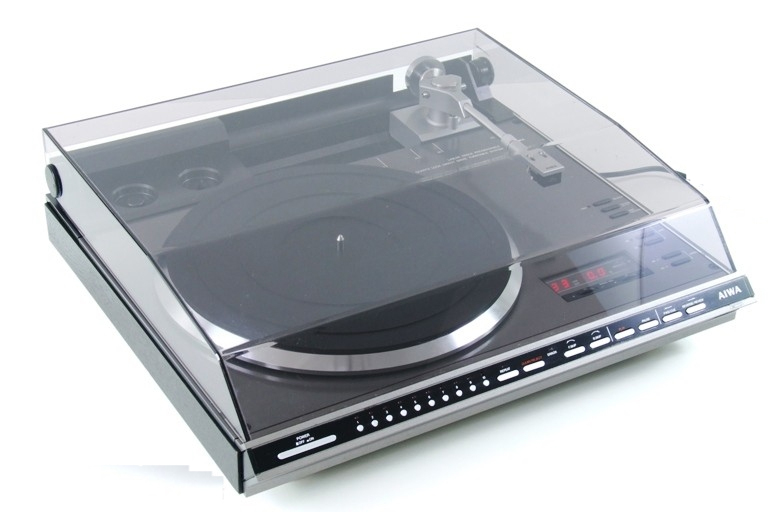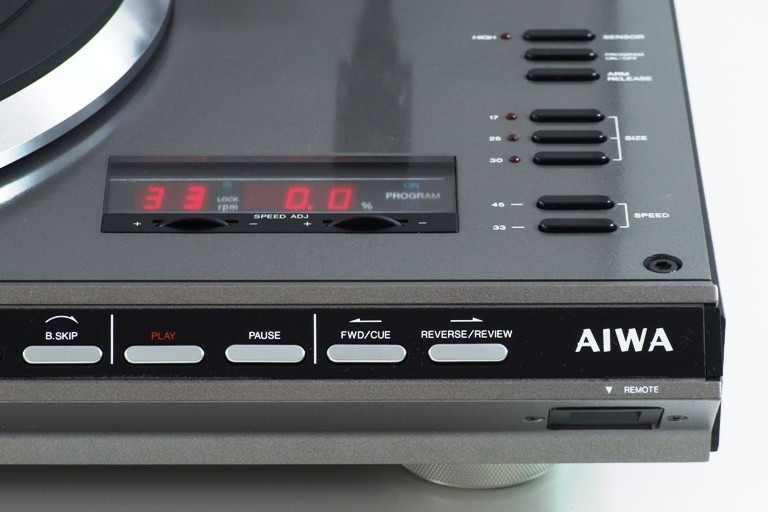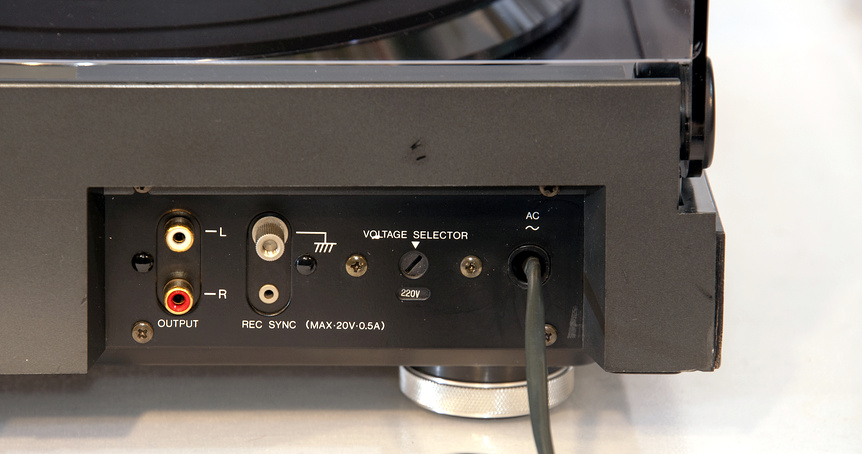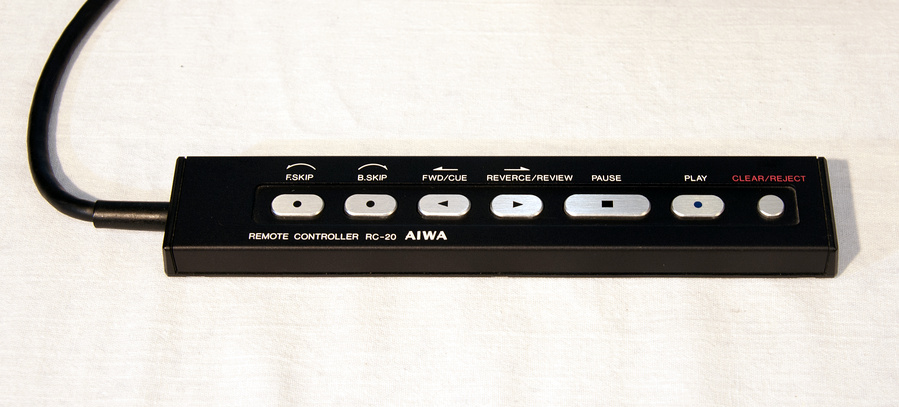Difference between revisions of "Aiwa LP-3000"
(Die Seite wurde neu angelegt: „ __NOTOC__ == Daten == {{Navigation}} '''Allgemein''' * Hersteller: Luxman * Modell: PD-441 * Typ: Direktangetriebener Plattenspieler * Baujahre: 1977 - 1…“) |
|||
| (17 intermediate revisions by the same user not shown) | |||
| Line 1: | Line 1: | ||
| + | __NOTOC__ | ||
| + | == Data == | ||
| + | {{navigation}} | ||
| + | '''General''' | ||
| + | * Manufacturer: [[Aiwa]] | ||
| + | * Model: LP-3000 | ||
| + | * Type: Direct drive turntable with tangential arm | ||
| + | * Years of manufacture: 1979 - 1981 | ||
| + | * Made in: Japan | ||
| + | * Colour: Black | ||
| + | * Remote control: RC-20 wired remote control | ||
| + | * Power consumption: 20 W | ||
| + | * Dimensions: (WxDxH) 480 x 439 x 150mm. | ||
| + | * Weight: 15.2 kg | ||
| + | * Original price, approx.: 168'000 Yen (Japan, 1979), 2500 DM | ||
| + | * Original price cable remote control RC-20, approx.: 65 US-$, 160 DM | ||
| + | |||
| + | |||
| + | '''Connections''' | ||
| + | * Outputs: 1 | ||
| + | ** Output voltage: 3,3 mV | ||
| − | + | '''Technical Data''' | |
| − | + | * 3 motors drive: | |
| − | + | ** 1 x Pulse Synthesizer Quartz PLL Servo direct drive for the turntable. | |
| − | ''' | + | ** 1 x motor for the horizontal movement of the tonearm |
| − | * | + | ** 1 x motor for the vertical movement of the pickup |
| − | * | + | * Speed: 33 1/3 / 45 revolutions/min. |
| − | * | + | * Speed fine adjustment: ± 6% |
| − | * | + | * Brake mechanism: fully electronic |
| − | * | + | * Turntable: |
| − | * | + | ** Diameter: 310mm |
| − | * | + | ** Weight: 2,5 kg |
| − | * | + | ** Moment of inertia: 500kg / cm2 |
| − | * | + | ** Torque at start: > 1 kg/cm |
| − | * | + | ** Material: Zinc die casting |
| − | * | + | * Synchronisation fluctuation: < 0,025% |
| + | * Signalrauschabstand: >73dB | ||
| + | * Turntable: , torque | ||
| + | * Tonearm: Linear scanning with statically balanced tonearm | ||
| + | * Effective length: 182 mm | ||
| + | * Sensitivity of rotation axis: | ||
| + | *** Horizontal: 30 mg | ||
| + | Vertical: 30 mg | ||
| + | ** Tracking force: 0 - 3 grams | ||
| + | * Pickup: | ||
| + | ** Pickup weight: 4 to 29 grams possible (with additional headshell or additional weights). | ||
| + | ** Headshell weight: 16.5g (die-cast aluminium) | ||
| + | ** Type of cartridge supplied: MM | ||
| + | ** Frequency response: 20Hz...20 kHz | ||
| + | ** Output voltage: 3.3 mV | ||
| + | ** Stereo channel separation: 25 dB (1Khz) | ||
| + | ** Load impedance: 47 kOhm | ||
| + | ** VTA: 20° | ||
| + | ** Tracking force: 1 gram (+0.5 / -0.25g) | ||
| + | ** Needle type: 0.2mil x 0.7mil diamond, elliptical cut | ||
| + | |||
| + | |||
| + | '''Special Features''' | ||
| + | * Tangential tone arm | ||
| + | * Program storage and function control via microprocessor | ||
| + | * Front operation even with closed hood | ||
| + | * Synchronisation control to "Aiwa cassette decks" * Digital speed display | ||
| + | * Digital speed display | ||
| + | * Automatic operation by preselecting up to 15 music titles in any order | ||
| + | * Automatic repeats of the entire program up to 10 or 24-repeats when the Repeat button is pressed alone | ||
| + | * RC-20 wired remote control | ||
| + | |||
| + | |||
| + | == Remarks == | ||
| + | * The tangential tonearm guides the pickup radially towards the center of the record. This in contrast to the rotary tonearm, which moves the pickup in a circular arc rotating over the record. | ||
| + | The tangential tonearm scans the groove under the same conditions as the stylus cut it during recording. It therefore does not form a tangential skew angle and prevents the force component known as skating. | ||
| + | * In the Aiwa system, the tangential tone arm is electrically guided over the record by a threaded spindle. It is mounted on a guide arranged horizontally behind the turntable. | ||
| + | * The movement is controlled electronically by an "identification unit" located in the sound head, which consists of an infrared light-emitting diode and a phototransistor. It determines whether a record is on the turntable, detects the sections between the individual pieces of music and determines the respective point of contact of the needle with the record. | ||
| + | * The tracking of the tonearm according to the groove pitch is done by a photoelectric system at the tonearm bearing, which already tracks the tonearm at a lateral tonearm deflection of only 1/4°. The angle of 90° formed by the tonearm and the plate radius is practically maintained, so that the tangential misalignment angle remains insignificantly small. | ||
| + | |||
| + | |||
| + | * Other models in the same series: | ||
| + | * Receiver: | ||
| + | * [[Aiwa AX-7300]] | ||
| + | * [[Aiwa AX-7700]] | ||
| + | * [[Aiwa AX-7800]] | ||
| + | |||
| + | |||
| + | * [[Tape Deck]] | ||
| + | * [[Aiwa AD-M 250]] | ||
| + | * [[Aiwa AD-L 300]] | ||
| + | * [[Aiwa AD-L 450]] | ||
| + | * [[Aiwa AD-R 500]] | ||
| + | * [[Aiwa AD-M 700]] | ||
| + | * [[Aiwa AD-M 800]] | ||
| + | * [[Aiwa SD-L 50]] | ||
| − | + | * [[Record Player]] | |
| − | * | + | * [[Aiwa AP-D 30]] |
| − | * | + | * [[Aiwa AP-D 50]] |
| + | * [[Aiwa AP-2100]] | ||
| + | * [[Aiwa LP-3000]] | ||
| − | + | * [[Noise Reduction System]] | |
| − | * | + | * [[Aiwa HR-50]] |
| − | * | ||
| − | |||
| − | |||
| − | |||
| − | |||
| − | |||
| − | |||
| − | + | == Pictures == | |
| − | * | + | * Aiwa LP-3000 hood open |
| − | + | [[File:Aiwa LP-3000-1.jpg]] | |
| + | * Aiwa LP-3000 hood closed | ||
| + | [[File:Aiwa LP-3000-3.jpg]] | ||
| − | + | * Aiwa LP-3000 control panel | |
| − | * | + | [[File:Aiwa LP-3000-4.jpg]] |
| − | |||
| − | |||
| − | |||
| − | |||
| + | * Aiwa LP-3000 connector panel back panel | ||
| + | [[File:Aiwa LP-3000-6.jpg]] | ||
| − | + | * Aiwa LP-3000 wired remote control RC-20 | |
| − | * | + | [[File:Aiwa LP-3000-7.jpg]] |
| − | [[ | ||
| − | == | + | == Reports == |
== Links == | == Links == | ||
| − | * | + | * External Link: "Hifi Archive" website: [http://www.hifi-archiv.info/Aiwa/1979-1/09.JPG] |
| − | |||
| − | |||
| − | * | + | * External Link: "The Vintage Knob" website: [http://www.thevintageknob.org/aiwa-LP-3000.html] |
| − | [[ | + | [[Category:Turntables]]</0,025%> |
Latest revision as of 11:44, 16 November 2018
Data[edit]
General
- Manufacturer: Aiwa
- Model: LP-3000
- Type: Direct drive turntable with tangential arm
- Years of manufacture: 1979 - 1981
- Made in: Japan
- Colour: Black
- Remote control: RC-20 wired remote control
- Power consumption: 20 W
- Dimensions: (WxDxH) 480 x 439 x 150mm.
- Weight: 15.2 kg
- Original price, approx.: 168'000 Yen (Japan, 1979), 2500 DM
- Original price cable remote control RC-20, approx.: 65 US-$, 160 DM
Connections
- Outputs: 1
- Output voltage: 3,3 mV
Technical Data
- 3 motors drive:
- 1 x Pulse Synthesizer Quartz PLL Servo direct drive for the turntable.
- 1 x motor for the horizontal movement of the tonearm
- 1 x motor for the vertical movement of the pickup
- Speed: 33 1/3 / 45 revolutions/min.
- Speed fine adjustment: ± 6%
- Brake mechanism: fully electronic
- Turntable:
- Diameter: 310mm
- Weight: 2,5 kg
- Moment of inertia: 500kg / cm2
- Torque at start: > 1 kg/cm
- Material: Zinc die casting
- Synchronisation fluctuation: < 0,025%
- Signalrauschabstand: >73dB
- Turntable: , torque
- Tonearm: Linear scanning with statically balanced tonearm
- Effective length: 182 mm
- Sensitivity of rotation axis:
- Horizontal: 30 mg
Vertical: 30 mg
- Tracking force: 0 - 3 grams
- Pickup:
- Pickup weight: 4 to 29 grams possible (with additional headshell or additional weights).
- Headshell weight: 16.5g (die-cast aluminium)
- Type of cartridge supplied: MM
- Frequency response: 20Hz...20 kHz
- Output voltage: 3.3 mV
- Stereo channel separation: 25 dB (1Khz)
- Load impedance: 47 kOhm
- VTA: 20°
- Tracking force: 1 gram (+0.5 / -0.25g)
- Needle type: 0.2mil x 0.7mil diamond, elliptical cut
Special Features
- Tangential tone arm
- Program storage and function control via microprocessor
- Front operation even with closed hood
- Synchronisation control to "Aiwa cassette decks" * Digital speed display
- Digital speed display
- Automatic operation by preselecting up to 15 music titles in any order
- Automatic repeats of the entire program up to 10 or 24-repeats when the Repeat button is pressed alone
- RC-20 wired remote control
Remarks[edit]
- The tangential tonearm guides the pickup radially towards the center of the record. This in contrast to the rotary tonearm, which moves the pickup in a circular arc rotating over the record.
The tangential tonearm scans the groove under the same conditions as the stylus cut it during recording. It therefore does not form a tangential skew angle and prevents the force component known as skating.
- In the Aiwa system, the tangential tone arm is electrically guided over the record by a threaded spindle. It is mounted on a guide arranged horizontally behind the turntable.
- The movement is controlled electronically by an "identification unit" located in the sound head, which consists of an infrared light-emitting diode and a phototransistor. It determines whether a record is on the turntable, detects the sections between the individual pieces of music and determines the respective point of contact of the needle with the record.
- The tracking of the tonearm according to the groove pitch is done by a photoelectric system at the tonearm bearing, which already tracks the tonearm at a lateral tonearm deflection of only 1/4°. The angle of 90° formed by the tonearm and the plate radius is practically maintained, so that the tangential misalignment angle remains insignificantly small.
- Other models in the same series:
- Receiver:
- Aiwa AX-7300
- Aiwa AX-7700
- Aiwa AX-7800
- Tape Deck
- Aiwa AD-M 250
- Aiwa AD-L 300
- Aiwa AD-L 450
- Aiwa AD-R 500
- Aiwa AD-M 700
- Aiwa AD-M 800
- Aiwa SD-L 50
Pictures[edit]
- Aiwa LP-3000 hood open
- Aiwa LP-3000 hood closed
- Aiwa LP-3000 control panel
- Aiwa LP-3000 connector panel back panel
- Aiwa LP-3000 wired remote control RC-20
Reports[edit]
Links[edit]
- External Link: "Hifi Archive" website: [1]
- External Link: "The Vintage Knob" website: [2]</0,025%>
